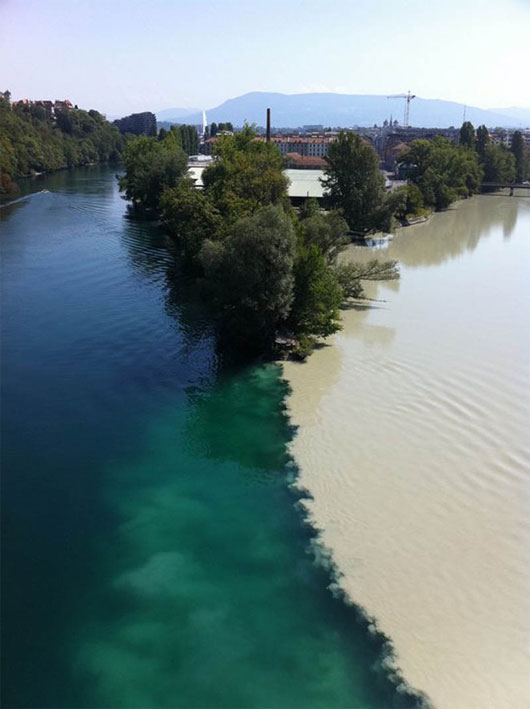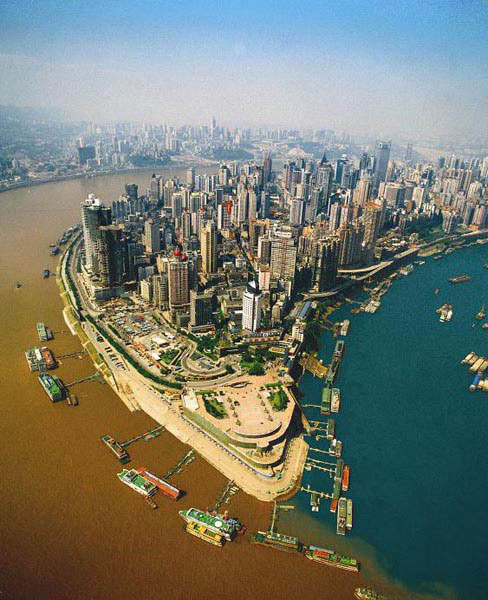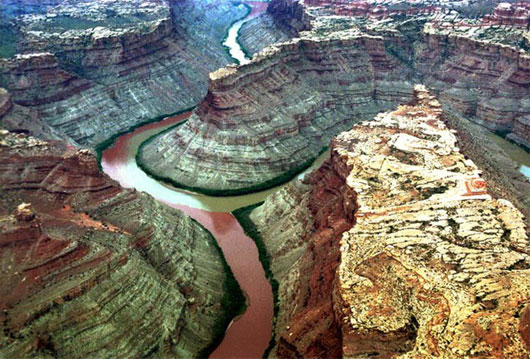Confluent rivers are not suitable for color matching
The confluence is the place where the two rivers intersect but not all two streams enter one and dissolve with each other. Due to velocity, water flow and temperature, many water streams carry two different colors. Let's admire the rivers with such two wonderful colors.
River Rhone and River Arve, Geneva, Switzerland

The combination of the blue Rhone river on the left and Arve is on the right with the muddy, muddy water from the glaciers of the Chamonix Valley .
Jialing River and Yangtze River in Chongqing, China

The left side of Chongqing city is the 119-kilometer Gia Lang river, which carries many silt so the water is reddish-brown. The blue river on the starboard side of the city is the Yangzi River. Thanks to the merger with Jialing, the Yangtze River has a stronger flow of water for the Three Gorges Dam thousands of miles away.
Blue River and Colorado River, Utah, USA

The Blue River forms from the Rocky Mountains of Sublette, Wyoming. After winding around northern Utah, it enters eastern Colorado and then back to southern Utah and joins the Colorado River in Canyonlands National Park. Although the canyons here are very narrow, but when combined with the stream, these two rivers retain their original colors without being mixed.
Ohio River and Mississippi River, Illinois River, USA

The Ohio River was formed from Pittsburgh, Pennsylvania and after flowing through many states along the southwest, it matched the Mississippi River at the junction of Cairo, Illinois. These two rivers retain their color despite the confluence and this blue-brown split image that extends all the way to the Gulf of Mexico .
Alaknanda River and Bhagirathi, Devprayag, India

The Alaknanda River is the result of a confluence between two Satopanth and Bhagirath Kharak glaciers of Uttarakhand. Bhagirathi River is made from Gangotri and Khatling glaciers in the majestic Himalaya range. These two white-green rivers combine to form two of the five major tributaries that make up the Ganges but have never mixed in the colors.
The Ilz, Danube and Inn rivers merge at Passau, Germany

The city of Passau carries in itself a three-color river by the strange confluence of the Ilz, Danube and Inn rivers. If the Ilz river has a small ocean blue, the River Inn originates from Salzburg, has a huge flow of water, but when it reaches the Passau, it merges with a part of the Danube and Ilz, the three-colored river This is named the Danube.
Drava and Danube rivers, Osijek, Croatia

The giant Danube stretches across Croatia to be alluvial brown and confluent with the green Drava line originating in the Italian Alps. Thanks to the abundance of silt, a part of the Drava river bordering the Danube also fades when mixed with silt. However, these two rivers still carry two completely different colors on both sides.
Moselle and Rhine River, Koblenz, Germany

Carrying in a separate river with two separate colors, the city of Koblenz in German also means " confluence ". Rhine is the 12th largest river in Europe, originating from the Swiss Alps and flowing through many European countries. Moselle part of the river is green, originating from France, flowing through Luxembourg and confusing with the Rhine at Koblenz.
Rio Negro and Rio Solimoes, Manaus, Brazil

Rio Negro is a river that is almost black when it merges with the mud-colored Rio Solimoes, which extends up to 6 km without blending colors. This phenomenon is explained by differences in temperature, flow and river flow . In it, the Negro only flows at 2km / h in temperatures of 28 degrees Celsius and Solimoes flows 6km / h at 22 degrees Celsius.
River Thompson and Frasee, Lytton, Canada

After crossing British Columbia, the blue Thompson River almost ended at Lytton and joined up with Canada's longest and most muddy river - Fraser. Despite keeping up with the muddy river, Thompson has not been blended at all but still retains his green look.
Rio Uruguay River and its branch - Argentina

The confluence of the Rio Uruguay River and its tributary in the province of Misiones, Argentina is also one of the "uncommonly famous rivers ". The Rio Uruguay river has dark red water due to heavy rains that wash away the iron in the soil and flow into the river.
- Rivers are infected with antibiotics
- Ash replacement cement
- In the north, there is a widespread rain, and floods appear on the rivers
- Why is tiger fur extremely orange red and still a god of green forest?
- 10 'dying' rivers of America (Part 1)
- 10 major rivers in the world are under threat
- Scientist 'went out' to clean up rivers and lakes
- Two more rivers disappeared after only one night in Mexico
- Why do human eyes have different colors?
- 1,000 dead ducks floating rivers in China
- This is the real reason why rivers never flow in a straight line
- History of color photography, from dreams to reality
 Is the magnetic North Pole shift dangerous to humanity?
Is the magnetic North Pole shift dangerous to humanity? Washington legalizes the recycling of human bodies into fertilizer
Washington legalizes the recycling of human bodies into fertilizer Lightning stone - the mysterious guest
Lightning stone - the mysterious guest Stunned by the mysterious sunset, strange appearance
Stunned by the mysterious sunset, strange appearance